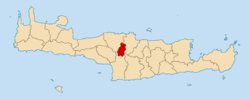Anogia
|
Parish of Anogia Δήμος Ανωγείων (Ανώγεια) |
||
|---|---|---|
|
|
||
| Basic data | ||
| State : |
|
|
| Region : | Crete | |
| Regional District : | Rethymno | |
| Geographic coordinates : | 35 ° 17 ' N , 24 ° 53' E | |
| Area : | 102.632 km² | |
| Residents : | 2,379 (2011) | |
| Population density : | 23.2 inhabitants / km² | |
| Seat: | Anogia | |
| LAU-1 code no .: | 7304 | |
| Districts : | no | |
| Local self-government : | no | |
| Website: | www.anogialand.gr | |
| Location in the Crete region | ||
Anogia ( Greek Ανώγεια [ aˈnɔʝi̯a ] ( n. Pl. )) Is a municipality (Δήμος, Dimos ) in the northeast of the Psiloritis massif in the regional district of Rethymno on the Greek Mediterranean island of Crete , one of the 13 regions of Greece .
Today's Anogia parish is one of the few Greek parishes that remained unchanged by the 2010 Kallikratis law . The villages of Axos and Zoniana , which were incorporated into Anogia in 1997 , had already been spun off in 2006 : Axos came to the municipality of Kouloukonas, Zoniana became an independent rural municipality. Kouloukonas and Zoniana were incorporated into the new municipality of Mylopotamos in 2010 . According to the 2011 census, a total of 2379 residents lived permanently in the municipality at that time, 2,319 of them in Anogia itself and 60 in the hamlet of Sisarcha.
geography
The municipality of Anogia is located on the eastern border of the Rethymno Regional District and the Heraklion Regional District . It borders on the municipality of Mylopotamos in the northwest , Malevizi in the northeast , Festos in the south and Gortyna in the southeast .
Anogia is 54 kilometers from the regional capital of Rethymno and is located southeast on the Rethymno - Panormo - Perama - Anogia road. The distance to the island's capital Heraklion is 36 kilometers. The road leads to Heraklion via Sklavokambos and Tilisos. In the south of the municipality is the Nida plateau with the Idean grotto . Due to the remote location, local customs, costumes and a strong dialect have been preserved.
history
In the late Minoan period , the villa of Zominthos was located nearby . The ancient Oaxos was located near the current district of Axos .
During the Second World War , the place was a center of resistance against the Germans, who acted several times against residents of the village. On August 13, 1944, they destroyed the village in retaliation for the kidnapping of the German major general Heinrich Kreipe , commander of the 22nd Infantry Division, organized by Patrick Leigh Fermor . The order was that the whole village should be completely destroyed and that every male resident within a kilometer of the village should be killed. According to the official death register, the Germans executed 117 residents during the entire occupation. After the war the village was rebuilt.
- Order of August 13, 1944: “Because the city of Anogia is a center of English espionage activity on Crete, because the inhabitants of Anogia carried out the act of sabotage in Damasta, because the partisans of various resistance groups find protection and refuge in Anogia and because the kidnappers General Kreipe theirs Having taken the route via Anogia, using Anogia as a base for the shipment, we order the place to be razed to the ground and every male inhabitant of Anogia to be executed who is found within the village or in its vicinity at a distance of up to one kilometer. Chania August 13, 1944. The commander of the fortress of Crete, H. Müller ”.
economy
With around 100,000 sheep and goats, Anogia is a center of livestock farming. In summer the herds of sheep and goats graze on the Nida plateau.
Today Anogia is also a popular stopover for tourists. However, Anogia is also widely known for its weaving mills. The local women have formed a collective to manufacture and market them. Their beautiful handicrafts shape the appearance of the place because they are offered for sale on the roadside. Many workshops are open to the public. Weaving on large looms can be seen there.
Anogia is known as the hometown of many well-known Cretan musicians and poets from Mantinaden, including the Xylouris family with Nikos Xylouris (1936–1980).
museum
In a small private museum, works by the painter and sculptor Alkibiades Skoulas are exhibited, which in a naive style tell of the end of the Turkish occupation, the everyday life of the people and the painful history of the Second World War.
Sons and daughters of the church
- Spyridoula Toutoudaki (* around 1960), singer
- Nikos Xylouris (1936–1980), musician (see above)
- Psarantonis Xylouris (* 1942), musician
- Giorgis Xylouris (* 1965), musician
See also
supporting documents
- ↑ a b Results of the 2011 census at the National Statistical Service of Greece (ΕΛ.ΣΤΑΤ) ( Memento from June 27, 2015 in the Internet Archive ) (Excel document, 2.6 MB)


